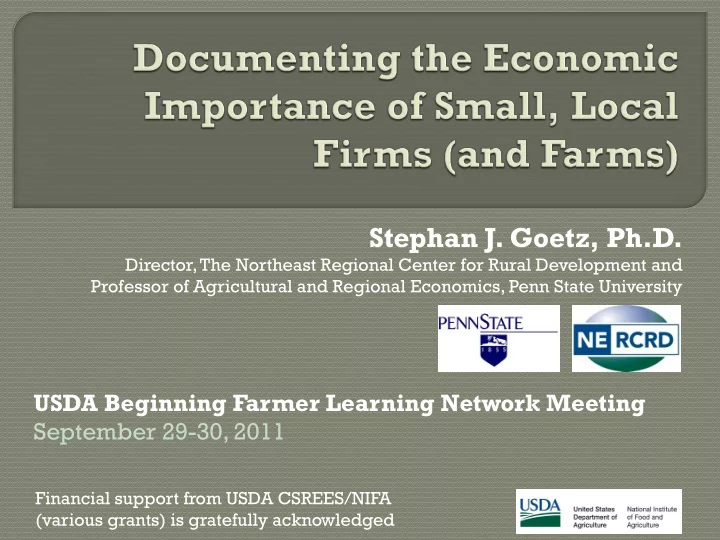

Stephan J. Goetz, Ph.D. Director, The Northeast Regional Center for Rural Development and Professor of Agricultural and Regional Economics, Penn State University USDA Beginning Farmer Learning Network Meeting September 29-30, 2011 Financial support from USDA CSREES/NIFA (various grants) is gratefully acknowledged
Using economic data to generate investment: Examples • Economic Census • IMPLAN Gap Analysis • Multivariate regression analysis (county-level)
Uses of Economic Census Data • Assist Local Businesses: A consultant uses economic census data from American FactFinder to compute business averages, such as sales per capita and establishments per 100,000 residents. She markets comparative summaries to prospective entrepreneurs. She advises them to look for opportunities in communities where an industry is underrepresented relative to state and national norms. Source : U.S. Census website
Uses of Economic Census Data • Site Location: A food store chain uses Economic Census data and population figures to estimate potential weekly food store sales in the trade area for each of its stores. These estimates allow the company to calculate market share for each existing store, and to evaluate prospective sites for new stores. Source : U.S. Census website
Uses of Economic Census Data • Site Location: A local foods retailer collects customer ZIP Codes from credit card transactions (or surveys). He links that information with demographic census and economic data to analyze how far customers are willing to come to shop at their stores and how that distance varies with the number of competing stores. He can then identify new clusters of ZIP Codes with favorable demographic and economic characteristics in which to locate new stores. Source : Adapted from U.S. Census website
Uses of Economic Census Data • Enhance business-opportunity presentations to banks or venture capitalists: An entrepreneur used census data to support her loan application, as she sought financing to start a tailoring and alterations shop for women executives. She used data from the Census of Service Industries on her line of business in conjunction with data on women in managerial occupations from the Census of Population. Source : U.S. Census website
IMPLAN-based gap analysis • Identify sectors or industries with substantial simultaneous imports AND exports • Consider opportunities for import substitution • Apply additional screens for targeting: – Large local multipliers – Employment/jobs (totals) – Wages or earnings – Growth in jobs or wages/earnings
Example of a Gap Analysis (NCHA, WV), Using IMPLAN Source: Daniel Eades, West Virginia University TABLE 2. IMPORTS OVER 100 MILLION DOLLARS $ (Millions) Imported Commodity Exports Imports Refined petroleum products 39.9 603.3 Real estate buying and selling, leasing, managing, and related services 0.6 461.8 Management of companies and enterprises 25.4 270.9 Non-depository credit intermediation and related services 0.1 267.8 Petrochemicals 296.3 242.9 Support services for other mining 362.3 241.8 Insurance 1.6 222.4 Other basic organic chemicals 53.9 218.5 Architectural, engineering, and related services 5.9 206.0 Wholesale trade distribution services 116.2 198.0 Iron and steel and ferroalloy products 450.8 193.3 Securities, commodity contracts, investments, and related services 7.0 174.9 Construction machinery 1.8 165.1 Leasing of nonfinancial intangible assets 4.5 163.9 Electricity, and distribution services 17.9 155.9 Legal services 4.4 122.3 Commercial and industrial machinery and equipment rental and leasing 11.4 114.7 Oil and natural gas 135.1 107.9 Motor vehicle parts 43.0 100.1
Disconnects: Panhandle of WV Source: Daniel Eades Sector Exports Intermediate Imports Cement 75.72 5.78 Ready-mix concrete 8.95 14.43 Concrete pipes, bricks, and blocks 0.09 3.30 Other concrete products 4.95 4.90 Paper from pulp 4.84 14.83 Paperboard from pulp 72.14 4.07 Paperboard containers 0.00 17.16 Flavoring syrups and concentrates 0.53 7.02 Soft drinks and manufactured ice 12.90 2.52 Wood windows and doors and millwork 6.51 8.74 Printed materials 34.75 27.83 Processed animal (except poultry) meat and rendered byproducts 11.47 11.92
Example of a Gap Analysis, Wisconsin, Using IMPLAN Source: Steve Deller, Ch. 19 in Goetz, Deller and Harris, Targeting Regional Economic Development , Routledge, UK, 2009. • The I-43 corridor exports $1bn worth of cheese, and imports $400mn worth of dairy farm products; suggests potential for expanded dairy farm operations • The same study identified $74.1 mn worth of feed grain exports, and $95.0 mn imports • Pulp mills: – imported $188.3mn – exported $76.2mn
Do Local Firms (and Small Farms) Matter • Consider the independent effect of locally owned, small firms on per person income growth • Holding constant other factors (causes of economic growth) • This is just like a fertilizer trial, in which fertilizer levels are varied while other factors are held constant (initial income; population density; land area; education; industry mix) • “Treatment”: firms by size, ownership Δ Y = f(Y 0 , PopDen, Area, Educ, IndMix, FirmType)
Effect of Small, Locally-Owned Firms (1) • Effect on per capita income growth in counties • Differentiated by firm size, ownership – Average number of firms per 1,000 population: Employees per firm Ownership 1-9 10-99 100-499 500+ Local 43.30* 4.63 0.20 0.02 Not-Local 1.50 0.87 0.16 0.02 – Statistically significant results obtained for the size and ownership combinations shown in bold italics • * = stat. significance depends on controls included Fleming, D. and S.J. Goetz (2011), “Does Local Firm Ownership Matter?” Economic Development Quarterly . 25(3), August: 277-81.
Effect of Small, Locally-Owned Firms (2) • One additional small (10-99 employees) locally- owned firm (per 1,000 popln) would raise annual per person income by $285; – additional household income of $1,140 (family of four) • A community that doubles the number of small, locally-owned firms from the average of 4.63 (to 9.26 firms per 1,000 pop) would see additional annual per household income of $5,278. • Doubling the number of very large , not locally- owned firms (from 0.02 to 0.04), would reduce average household income by $372 . Fleming, D. and S.J. Goetz (2011), “Does Local Firm Ownership Matter?” Economic Development Quarterly . 25(3), August: 277-81.
Thank You sgoetz@psu.edu http://nercrd.psu.edu
Recommend
More recommend